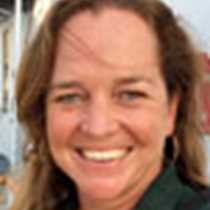Santa Cruz and North Seymour Islands
Our third day in the Galapágos Archipelago and the intense pace has not slowed down yet. What else could our relentless Expedition Staff have in store for us? How about an early morning, pre-breakfast outing to the highlands of an island to search for the inimitable Galapágos giant tortoise in the wild? Although it may sound too good to be true, that is exactly what we did today.
Santa Cruz is the second largest island in the group and as such is tall enough to intercept the low clouds that hang over the archipelago during much of the year, hence supporting several vegetation zones including moist forests and highland meadows. For some, a welcome relief from the desert-like conditions and prickly vegetation found throughout the coastal areas we have explored so far. Among those that particularly enjoy the humidity are those most emblematic of Galapágos species: the giant tortoise, Geochelone elephantopus. This island has a healthy population of these gargantuan beasts, which follow age-old seasonal trails up and down the island in search of either food or reproductive partners.
After meeting with complete success in our mission, we enjoyed a hearty buffet breakfast in a highland restaurant with spectacular views of both Santa Cruz and some of the surrounding islands. We then descended back to coastal level to explore one of the busiest port towns in the Galapágos, Puerto Ayora, home to our natural history staff and several shops, cafes and restaurants; as well as headquarters to the Charles Darwin Research Station and the Galapágos National Park Service.
Upon returning to the M/S Islander for lunch, we lifted anchor and sailed several miles to the north: our destination the tiny, uplifted islet of North Seymour. Although we assumed that things could not get any better than they already had been, our nature walk through the trails of this enchanted islet revealed courting frigate birds and their colonies, myriad tiny sea lion pups, swallow-tailed gulls, iguanas both land and marine, and flocks of blue-footed boobies plunge-diving against the backdrop of spectacular waves and a sun setting behind the islet of Daphne Major.
A thoroughly enjoyable day that surely cannot be topped – or can it? Check in with tomorrow’s expedition report!
Our third day in the Galapágos Archipelago and the intense pace has not slowed down yet. What else could our relentless Expedition Staff have in store for us? How about an early morning, pre-breakfast outing to the highlands of an island to search for the inimitable Galapágos giant tortoise in the wild? Although it may sound too good to be true, that is exactly what we did today.
Santa Cruz is the second largest island in the group and as such is tall enough to intercept the low clouds that hang over the archipelago during much of the year, hence supporting several vegetation zones including moist forests and highland meadows. For some, a welcome relief from the desert-like conditions and prickly vegetation found throughout the coastal areas we have explored so far. Among those that particularly enjoy the humidity are those most emblematic of Galapágos species: the giant tortoise, Geochelone elephantopus. This island has a healthy population of these gargantuan beasts, which follow age-old seasonal trails up and down the island in search of either food or reproductive partners.
After meeting with complete success in our mission, we enjoyed a hearty buffet breakfast in a highland restaurant with spectacular views of both Santa Cruz and some of the surrounding islands. We then descended back to coastal level to explore one of the busiest port towns in the Galapágos, Puerto Ayora, home to our natural history staff and several shops, cafes and restaurants; as well as headquarters to the Charles Darwin Research Station and the Galapágos National Park Service.
Upon returning to the M/S Islander for lunch, we lifted anchor and sailed several miles to the north: our destination the tiny, uplifted islet of North Seymour. Although we assumed that things could not get any better than they already had been, our nature walk through the trails of this enchanted islet revealed courting frigate birds and their colonies, myriad tiny sea lion pups, swallow-tailed gulls, iguanas both land and marine, and flocks of blue-footed boobies plunge-diving against the backdrop of spectacular waves and a sun setting behind the islet of Daphne Major.
A thoroughly enjoyable day that surely cannot be topped – or can it? Check in with tomorrow’s expedition report!




